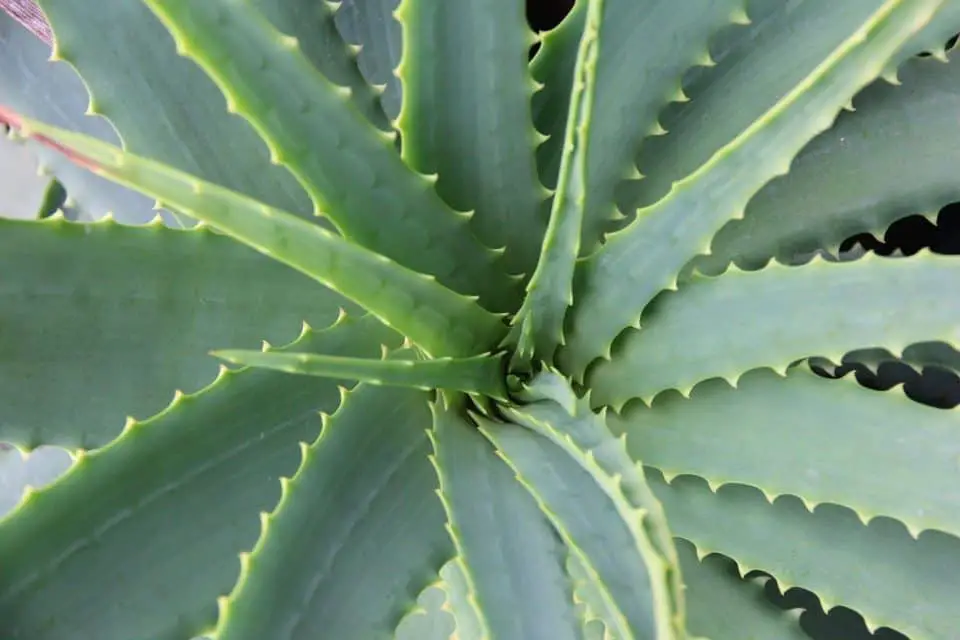Some links in the post are affiliate links and I get a commission from purchases made through some links found in the post.
It is important to keep your aloe plant dry most of the time. If it is overwatered, your aloe vera plant will rot and eventually die.
The Aloe Plant
Aloe vera are among the most popular house plants – and for good reason.
With their stemless, fleshy green leaves arranged in a whorl and spiky cactus-like appearance they are uniquely attractive.
On top of that, they are easy to manage. They don’t require any special care or pruning. In fact, they are at their best when you ignore them!
As we mentioned before, it’s best for your aloe vera plant to be overwatered. Once every three weeks should do the trick.
Just leave them in a bright spot, preferably out of direct sunlight, and let them do their thing.
Unfortunately, it is extremely rare to get an indoor aloe plant to flower. For that, they require year-round warm temperatures and searing desert sun.
Yet when they do manage to flower, they are quite beautiful, sending up a cone covered in red and orange bells known as an inflorescence.
If you have overwatered your aloe vera plant and you notice it early then you may be able to dry the soil out before any damage is done.
If there is a large amount of damage done, mushy or dead leaves and roots and other forms of damage you may still be able to save some of the plant.
Remove any of the damaged parts and repot the plant in new soil.
Some Background Information on Aloe Vera Plants
Aloe vera is a succulent species, meaning that it stores as much water as possible in its leaves. This is because it is native to areas of Africa and the Middle East that are desert.
All plants do best in conditions that are as close as possible to those in their native range.
Because aloe is adapted to dry conditions, it is important to maintain those conditions and water your plant sparingly.
If you give it too much water, the water storage cells located in the leaves will burst causing them to become mushy and decompose from the inside.
Also, if the soil stays wet around the roots, they can begin to rot as well.
How to Plant and Care for your Aloe Vera Plant
Choosing the Right Container
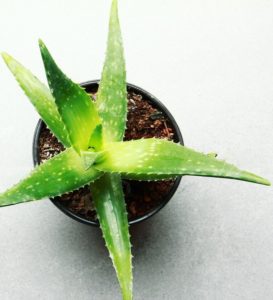 Many gardeners recommend using clay or terracotta pots because these are porous and dry out quickly.
Many gardeners recommend using clay or terracotta pots because these are porous and dry out quickly.
You may use pots made of other materials such as ceramic or plastic, but be aware that these will make the soil retain moisture – so if these are all that is available, adjust your watering routine accordingly.
Also, be sure to choose a container that is wide and stable. Aloe plants are fairly top-heavy and can sometimes grow on a slant so the right pot will prevent it from tipping over.
Most importantly, find a container with at least one good drainage hole.
Preparing the Soil
Make sure that you choose soil that does not remain damp. Regular potting or gardening soil holds onto its moisture a little too much, so it’s important to buy a mix that is meant for succulents.
These mixes can include perlite or vermiculite, wood or bark chips, sand, lava rock (pumice) or a mixture of all three.
This is closer to the soil of aloe vera’s natural habitat, so your plant will feel right at home. The water will pass right through the earth and leave the roots nice and dry.
Potting your Aloe Plant
Like with all plants, begin by putting a thin layer of gravel at the bottom of the pot, over the drainage hole.
If you don’t have this, you can use the shards of a broken clay pot, a screen or even a piece of newspaper.
This will keep the water draining nicely and keep the soil from falling out the bottom of the pot.
Once you’ve placed your screen or gravel at the bottom of the pot, fill the pot up about one third of the way, then position your aloe vertically in the pot and fill it up the rest of the way.
You should remember to leave about an inch between the top of the soil and the rim of the pot.
If your aloe plant has a stem, trim it until it fits in the pot. You should plant the stem under the soil, as it will send out roots as well.
You can coat the stem lightly in rooting hormone to encourage it to grow roots faster.
One extra tip: if you do have to cut the stem, leave it out for three to four days so that it can form a callous. If the wound is open when you plant it, rot can set in and kill the plant.
You may also like: Why does my aloe plant have no roots
Next steps
Keep your aloe plant in a bright spot out of direct sunlight as much as possible. A western or southern facing window is ideal.
The temperature should be fairly constant – between 13 and 27 degrees celsius (50 to 85 fahrenheit).
This is not too difficult to do as it is unlikely that your house’s temperature will be outside that range.
Though you should not water often, water thoroughly. Every three weeks is the standard frequency. Make sure your aloe vera plant is not overwatered.
It’s important to let the soil dry out between waterings, as the roots hate to be left in water. Before you water, touch the soil to make sure it’s dry.
Growing Aloe Sprouts
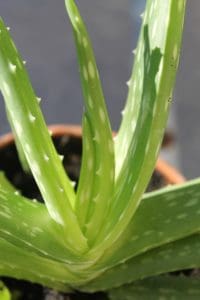 Another great thing about aloe plants is that they divide readily and make babies that are easy to replant.
Another great thing about aloe plants is that they divide readily and make babies that are easy to replant.
Once they are well established aloe plants will send up pups, or miniature versions, that are perfect clones of the mother plant.
It is much easier to plant a clone than it is to grow aloe from seed, partly because they flower so rarely.
To harvest the pups, carefully pull up the mother plant. You will see the babies attached to the stem.
Using a sharp knife, detach the pups making sure not to damage the roots (If the pup has no roots it will not grow on its own and is not ready to be detached).
Follow the instructions given above to pot the baby plant. Make sure scars heal and leave it in a sandy soil that is designed for succulents. It should begin to take hold in a week or so.
Problems with your Aloe Plant
Overwatered Aloe plant
Most of the problems home gardeners have with an aloe plant is related to being overwatered – either too much water is being given to the plant, or the soil doesn’t drain quickly enough.
Symptoms
You will find evidence of excess water in the leaves. They may develop brown spots or begin to soften, because the cells inside have burst from absorbing too much water.
Aloe vera leaves should be plump, firm and remain a nice dull green colour.
An overwatered aloe plant will the lead to the roots to rot. In a plant with severe root rot, they will weaken and even detach from the plant when you pull it up.
The remedy
The first thing to do is to remove the damaged leaves and stop watering for a while to let the soil dry out completely.
If it stays damp, you can repot your aloe plant in a sandier soil mix that is more suited to succulents, such as what we described earlier.
As you repot it, check the roots for signs of rot – brown, soft and mushy parts – and remove those.
Salt or Chemical Damage
These problems often occur with the overuse of chemical fertilizers.
As the plant absorbs the useful nutrients, say potassium or nitrogen, a salt byproduct is left behind. Overtime, the salt builds up and the soil loses its fertility.
Other chemical damage can be caused by some toxic element in the environment, household cleaners are probably the most common for home gardeners.
Symptoms
If there is salt or chemical contamination it will often show up as brown spots on the leaves.
The Remedy
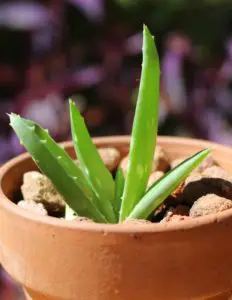 The first step is to remove the damaged leaves. If the salts or chemicals are present in the soil, due to overfeeding, you can repot the plant.
The first step is to remove the damaged leaves. If the salts or chemicals are present in the soil, due to overfeeding, you can repot the plant.
You can even try washing the salt out of the soil by running it under the tap. Of course you should remove the plant while you do this and allow the soil to dry before replanting.
If the chemicals are airborne, you may want to rethink the cleansers you are using at home, or at least protect the plant with a cover while you use them.
You can always try to move the plant to a safer environment. You should always try to keep your plants in the cleanest, least-polluted spot available.
To avoid the problem in the first place, don’t overfeed your aloe plant. A few drops of fertilizer every six weeks or so should be enough.
If you’re enjoying this article, check out our article on why are my aloe vera plant leaves bending.
Sun and Temperature Damage
Your aloe plant should be kept at the right conditions which we described above. Too much sun and the leaves will be scorched, too little and the plant will die.
The same goes for temperature. Your aloe will suffer if it is too cold or too hot.
Symptoms
Once again, the symptoms show up in the leaves. Brown or yellowish spots on the leaves are typical of sun scorch and wilting is to be expected if the plant is taken out of its ideal climate.
The remedy
Move your plant to place in line with the care instructions we listed above. This could depend on the season.
Depending on where you live, some windows in your home might be too sunny in the summer but just right in the winter.
You may also need to adjust your plant if it is close to the heater in the winter, which will cause it to dry out faster.
Leaf Rust
This is caused by a type of fungus growing on the leaves, though it’s not a very common problem.
Symptoms
You will see dark brown spots form on the leaves. Usually the problem stays localized but it can spread along a leaf or to others on the same plant.
The remedy
First remove the infected leaves to prevent it from spreading.
Afterwards, make sure that you keep the plant’s conditions dry and take care to avoid wetting the leaves when you water it.
Mealy Bugs
These are tiny insects that make their homes at the base of the stem of plants. They can attack many different species but are commonly found on aloe vera. They feed on the sap.
If you let them build up and form a nest they will eventually damage the plant. They also excrete a sticky substance known as ‘honeydew’ which can encourage the growth of mold.
Symptoms
They appear as fuzzy white bits of fluff around the stem of the plant.
The remedy
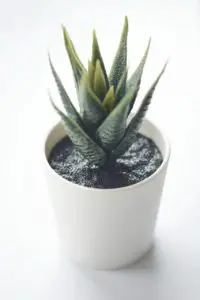 One common remedy recommended by gardeners is to wipe away the mealybug colony with a tissue or swab dipped in rubbing alcohol. This will kill the bugs.
One common remedy recommended by gardeners is to wipe away the mealybug colony with a tissue or swab dipped in rubbing alcohol. This will kill the bugs.
Then spray the entire plant with rubbing alcohol mixed with a few drops of biodegradable dish soap – this will get the alcohol to stick to the leaves.
Treating the plant two or three times with this formula should get rid of the infestation once and for all.
It’s a simple solution. However, once they are truly established, mealybugs can be too difficult to kill and you may need to toss out your plant and buy a whole new one.
Medicinal Uses
Aloe are also well known for their health benefits. It has been used for centuries if not longer as a way to rejuvenate and revitalize the skin.
Now modern research has backed up many of these claims.
Dermatologists recommend it as a moisturizer, antibacterial skin cream, it can speed the healing of wounds, reduce the appearance of scars and it can also soothe burnt (or sunburnt) skin.
It is also a powerful all-natural way of giving skin more elasticity and smoothing out those wrinkles, especially under the eyes.
Growing your own aloe plant is like bringing the pharmacy into your living room.
However, it’s important to note that for all the benefits it can bring to the skin, it is not meant to be ingested.
To use the leaves, cut them off at the base then squeeze the gel out.
Alternatively, you can mash the entire leaf up with a mortar and pestle or in some other container. Apply the gel to the affected area.
Varieties of Aloe Plants
Aloe Vera is the most famous plant in its family, but did you know that it has over 400 cousins?
There are many distinct types of aloes, many of which would also look great in your home and come with similar health benefits to aloe vera. Here is a list of some popular aloe varieties:
Stone Aloe – Aloe Petricola
This one resembles aloe vera but has leaves that are blue/grey. It has similar flowers and can also be used to treat small cuts and wounds.
Climbing Aloe – Aloe Ciliaris
As its name suggests, this one can grow very long, up to five metres. However, it needs the support of another plant or a tree to help keep it up.
If not, it will run along the ground and take root where the stem touches the earth, but it will appear scraggly and leggy until it grows vertically. These will also flower year round in the right conditions.
Candelabra Aloe – Aloe Arborescens
A beautiful specimen with sprawling leaves, this type of aloe can grow up to ten feet tall, the size of a small tree.
This species of aloe has showy red flowers that shoot up above the leaves. Because of its greater size, it is distinctively attractive and prized among aloe gardeners.
Spider Aloe – Aloe Humilis
A great plant for beginner gardeners, it’s easy to grow and hard to kill. Like Aloe Vera its leaves are arranged in a rosette, stemless and come to a point.
They are also covered in white spots, distinguishing it from its more famous cousin. It’s gel has similar medicinal properties to Aloe Vera.
Coral Aloe – Aloe Striata
A very popular choice among home gardeners, this Aloe is a very hardy member of the family. Its leaves have a pink hue around the edges and are grey-green in the centre.
They also tend to curl up at the ends. It’s a beautiful, unique plant, due mostly to this special colouring.
If you plan to purchase one of these aloe varieties, follow the same instructions to take care of it as you would for aloe vera.
Final Thoughts: What Happens to an Overwatered Aloe Vera Plant?
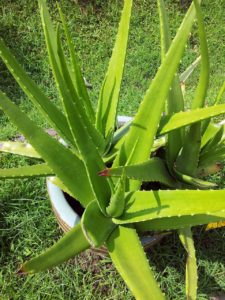 Aloe vera comes highly recommended for both the novice and expert home gardener. It is attractive, easy to grow and has tremendous healing powers for your skin.
Aloe vera comes highly recommended for both the novice and expert home gardener. It is attractive, easy to grow and has tremendous healing powers for your skin.
Though we’ve mentioned some problems that can affect your aloe, for the most part they are easy to avoid if you maintain the correct conditions for your plant especially by your aloe vera plant not being overwatered
And if you’re patient and let your aloe grow long enough, it sprouts babies which make great, free gifts.
If you love plants like I do, don’t wait any longer, get out there and find yourself an aloe. It will make a great plant companion!
Before you go, here are some more related articles I encourage you to read below to help solve more of your gardening issues:

